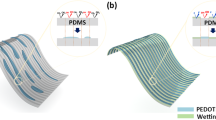Abstract
A process was developed for patterning thin films of environmentally sensitive hydrogels onto silicon microcantilevers. Microcantilevers have been shown to be ultra-sensitive transducers for chemical, physical, and biological microsensors. By patterning environmentally sensitive hydrogels onto silicon microcantilevers, novel microsensors were prepared for MEMS and BioMEMS applications. Specifically, a cross-linked poly(methacrylic acid) (PMAA) network containing significant amounts of poly(ethylene glycol) dimethacrylate (PEGDMA) was studied. This hydrogel exhibits a swelling dependence on pH. By increasing the environmental pH above the pKa of PMAA to cause ionization of the carboxylic acid groups, electrostatic repulsion is produced along the main polymer chain causing the polymer network to expand and swell. Therefore, a pH change induces swelling or shrinking of the polymer network and creates stress on the microcantilever surface causing it to bend. In this study, silicon microcantilevers were fabricated on p-type (100) SOI wafers. Covalent adhesion was gained between the polymer and the silicon surface through the modification of the silicon surface with ?-methacryloxypropyl trimethoxysilane. Hydrogels were patterned onto the silicon microcantilevers utilizing a mask aligner to allow for precise positioning. The micropatterned hydrogels were analyzed using optical microscopy and profilometry. The bending response of patterned cantilevers with a change in environmental pH was observed, providing proof-of-concept for a MEMS/BioMEMS sensor based on microcantilevers patterned with environmentally sensitive hydrogels.
Similar content being viewed by others
References
N.A. Peppas, J. Bioact. Compat. Polym. 6, 241–246 (1991).
N.A. Peppas, Hydrogels in Medicine and Pharmacy, (CRC Press, Boca Raton, FL, 1986).
Y. Ito, Biomaterials 20, 2333–2342 (1999).
Y. Nakayama, J.M. Anderson, and T. Matsuda, J. Biomed. Mater. Res. (Appl. Biomater.) 53, 584–591 (2000).
D.J. Beebe, J.S. Moore, J.M. Bauer, Q. Yu, R.H. Liu, C. Devadoss, and B. Jo, Nature 404, 588–590 (2000).
D.J. Beebe, J.S. Moore, Q. Yu, R.H. Liu, M.L. Kraft, B. Jo, and C. Devadoss, Proc. Natl. Acad. Sci. U.S.A. 97, 13488–13493 (2000).
G. Wu, H. Ji, K. Hansen, T. Thundat, R. Datar, R. Cote, M.F. Cote, M.F. Hagan, A.K. Chakraborty, and A. Majumdar, Proc. Natl. Acad. Sci. U.S.A. 98, 1560–1564 (2001).
A. Hierlemann, A.J. Ricco, K. Bodenhofer, A. Dominik, and W. Gopel, Anal. Chem. 72, 3696–3708 (2000).
C. Hagleitner, A. Hierlemann, D. Lange, A. Kummer, N. Kerness, O. Brand, and H. Baltes, Nature 414, 283–286 (2001).
A.M. Moulin, S.J. O’Shea, and M.E. Welland, Ultramicroscopy 82, 23–31 (2000).
Author information
Authors and Affiliations
Rights and permissions
About this article
Cite this article
Zachary Hilt, J., Gupta, A.K., Bashir, R. et al. A Microsensor Based on a Microcantilever Patterned with an Environmentally Sensitive Hydrogel. MRS Online Proceedings Library 729, 48 (2002). https://doi.org/10.1557/PROC-729-U4.8
Published:
DOI: https://doi.org/10.1557/PROC-729-U4.8




